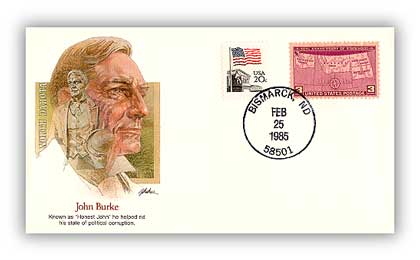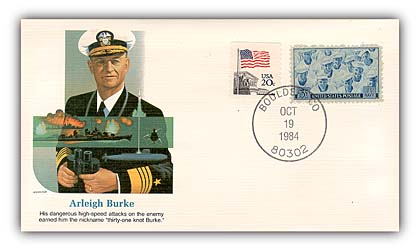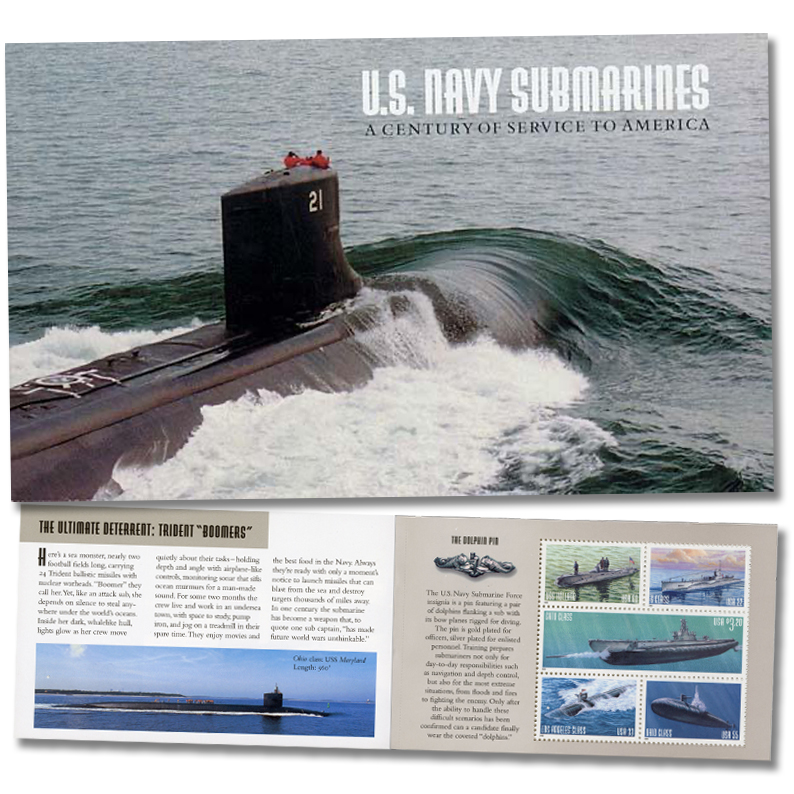
# 4441 - 2010 44c Distinguished Sailors: Arleigh A. Burke
Distinguished Sailors –
Arleigh A. Burke
Issue Date: February 4, 2010
First-day City: Washington, D.C.
Birth Of Arleigh Burke
Burke received his education in Boulder, but a 1918 influenza outbreak closed down the schools and he never graduated from high school. He then received an appointment to the US Naval Academy, from which he graduated in 1923.

Burke was then commissioned as an ensign and would spend the next 18 years serving on battleships and destroyers. During that time he also earned his Master of Science in Engineering degree from the University of Michigan. At the start of World War II, he was disappointed to receive a shore command at the Naval Gun Factory in Washington, DC. But he repeatedly requested to join in the conflict and in 1943 was ordered to the South Pacific.

For the rest of the war, Burke commanded several Destroyer Divisions and Squadrons. Among these was Destroyed Squadron 23, also known as the Little Beavers, a testament to how busy they were during the war. The Little Beavers covered the early landings at Bougainville and participated in 22 separate engagements in just four months. Burke also commanded his destroyers to attack on enemy contact without orders, arguing that hesitation had cost lives in the past.

During World War II Burke also earned the nicknamed “31-Knot Burke.” The newspapers and public saw it as a reference to his hard-charging and aggressive command. But the “31-Knot” part was a joke created by a colleague after one of Burke’s damaged ships was limited to a speed of 31-knots (most destroyers could easily go 34 knots).

During the battle of St. George, Burke’s five destroyers routed a Japanese fleet, sinking three Japanese ships and losing none. He was awarded the Navy Cross (the second-highest ranking medal) for “extraordinary heroism in operations against an armed enemy.”
In 1944, Burke was promoted to Chief of Staff to the Commander of Task Force 58, a position he held until the end of the war. After the war, he took command of the USS Huntington, was promoted to rear admiral, and served as Navy Secretary on the Defense Research and Development Board.
When the Korean War broke out, Burke was made Deputy Chief of Staff to Commander Naval Forces, Far East. He was then given command of Cruiser Division Five. In July 1951, Burke was made a part of the UN Truce Delegation, helping to negotiate an armistice. After that, he served as Director of Strategic Plans Division until 1954. Burke then commanded Cruiser Division Six and Destroyer Force Atlantic Fleet before being made Chief of Naval Operations.
As Chief of Naval Operations, Burke worked 15-hour days, six days a week. He supported the creation of a nuclear-powered submarine force and submarine-launched ballistic missiles, which led to the Polaris missile program.

Burke served for an unprecedented three terms as Chief of Naval Operations, before retiring in 1961. Thirty years later, he was present at the commissioning ceremony of the USS Arleigh Burke. He died on January 1, 1996.
During his career, Burke received some of the highest medals and citations the Navy offered. These included the Navy Cross (three times), the Navy Distinguished Service Medal (twice), the Legion of Merit (four times), and the Presidential Medal of Freedom.
Distinguished Sailors –
Arleigh A. Burke
Issue Date: February 4, 2010
First-day City: Washington, D.C.
Birth Of Arleigh Burke
Burke received his education in Boulder, but a 1918 influenza outbreak closed down the schools and he never graduated from high school. He then received an appointment to the US Naval Academy, from which he graduated in 1923.

Burke was then commissioned as an ensign and would spend the next 18 years serving on battleships and destroyers. During that time he also earned his Master of Science in Engineering degree from the University of Michigan. At the start of World War II, he was disappointed to receive a shore command at the Naval Gun Factory in Washington, DC. But he repeatedly requested to join in the conflict and in 1943 was ordered to the South Pacific.

For the rest of the war, Burke commanded several Destroyer Divisions and Squadrons. Among these was Destroyed Squadron 23, also known as the Little Beavers, a testament to how busy they were during the war. The Little Beavers covered the early landings at Bougainville and participated in 22 separate engagements in just four months. Burke also commanded his destroyers to attack on enemy contact without orders, arguing that hesitation had cost lives in the past.

During World War II Burke also earned the nicknamed “31-Knot Burke.” The newspapers and public saw it as a reference to his hard-charging and aggressive command. But the “31-Knot” part was a joke created by a colleague after one of Burke’s damaged ships was limited to a speed of 31-knots (most destroyers could easily go 34 knots).

During the battle of St. George, Burke’s five destroyers routed a Japanese fleet, sinking three Japanese ships and losing none. He was awarded the Navy Cross (the second-highest ranking medal) for “extraordinary heroism in operations against an armed enemy.”
In 1944, Burke was promoted to Chief of Staff to the Commander of Task Force 58, a position he held until the end of the war. After the war, he took command of the USS Huntington, was promoted to rear admiral, and served as Navy Secretary on the Defense Research and Development Board.
When the Korean War broke out, Burke was made Deputy Chief of Staff to Commander Naval Forces, Far East. He was then given command of Cruiser Division Five. In July 1951, Burke was made a part of the UN Truce Delegation, helping to negotiate an armistice. After that, he served as Director of Strategic Plans Division until 1954. Burke then commanded Cruiser Division Six and Destroyer Force Atlantic Fleet before being made Chief of Naval Operations.
As Chief of Naval Operations, Burke worked 15-hour days, six days a week. He supported the creation of a nuclear-powered submarine force and submarine-launched ballistic missiles, which led to the Polaris missile program.

Burke served for an unprecedented three terms as Chief of Naval Operations, before retiring in 1961. Thirty years later, he was present at the commissioning ceremony of the USS Arleigh Burke. He died on January 1, 1996.
During his career, Burke received some of the highest medals and citations the Navy offered. These included the Navy Cross (three times), the Navy Distinguished Service Medal (twice), the Legion of Merit (four times), and the Presidential Medal of Freedom.










